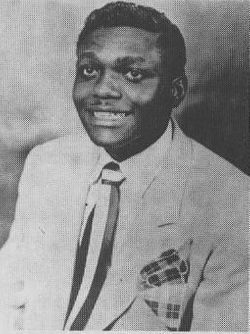First, Rock & Roll was neither “new,” nor indeed even a single musical style;
Second, the Rock & Roll era does not mark the first time that music was written specifically to appeal to young people;
Third, Rock & Roll was certainly not the first American music to fuse black and white popular styles.
============================
The identity of the first rock and roll record is one of the most enduring subjects of debate among rock historians.
As seen so far various recordings dating back to the 1940s have been cited as the first rock and roll record. A number of sources have considered the first to be "Rocket 88", which was recorded in 1951 by Ike Turner and his band, but credited to his saxophonist and the song's vocalist Jackie Brenston.
 |
| Jackie Breston |
"Rocket 88" had the basic characteristics of Rock & Roll music such as the emphasis on guitar and distortion. Its characterization as a rock and roll or rhythm and blues song continues to be debated. Nigel Williamson questions whether it was really an R&B song "with an unusually fast, bottom-heavy eight-to-the bar boogie rhythm and a great lyric about cars, booze and women".
=================================
Rock & Roll Stylistic Finger Prints:
- Instrumentation includes – male vocals, backing vocals, electric guitars, double bass, drums, piano, harmonica, saxophone and other brass
- Fast Tempo – 140bpm or faster Energetic delivery of vocals (screaming and shouting)
- Often based on 12-bar chord structure
- Predominantly uses major keys but with blues scale for vocals, lead parts and solos
- Strong back beat on beats 2 and 4
- Often uses a shuffle rhythm – slightly swung quavers
- Walking bass line, four to a bar, often based on ascending and descending patterns of root-3rd-5th-6th-flat 7th-6th-5th-3rd
- Quite often this line is doubled by electric guitar Second guitar plays rhythmic patterns of chords – use of 6th and 7th extensions of chords
- Use of “stop time” where instruments play only on beat 1 then leave space for vocals or instruments
- Use of flamboyant guitar solos
- Call and response – often between vocal and guitar
Music
- "Boogie in the Park" by Joe Hill Louis, recorded in July 1950 and released in August 1950,
- featured Louis as a one-man band performing "one of the loudest, most overdriven, and distorted guitar stomps ever recorded" while playing on a rudimentary drum kit at the same time. It was the only record released on Sam Phillips' early Phillips label before founding Sun Records.[82] Louis' electric guitar work is also considered a distant ancestor of heavy metal music.[83]
- "Hot Rod Race" recorded by Arkie Shibley and His Mountain Dew Boys in late 1950,
- another early example of "rockabilly", highlighted the role of fast cars in teen culture.[51]
- "Sixty Minute Man" by the Dominoes, recorded on December 30, 1950,
- was the first (and most sexually explicit) big R&B hit to cross over to the pop charts. The group featured the gospel-style lead vocals of Clyde McPhatter (though not on this song), and appeared at many of Alan Freed's early shows. McPhatter later became lead singer of the Drifters, and then a solo star.
- "Rocket 88" by Jackie Brenston and his Delta Cats
- (actually Ike Turner and the Kings of Rhythm) (1951), and
- Bill Haley and the Saddlemen (1951)
- Played with too much restraint compared to Breston and Ike
- "How Many More Years" recorded by Howlin' Wolf in May 1951.
- Robert Palmer has cited it as the first record to feature a distorted power chord, played by Willie Johnson on the electric guitar
- "Rock and Roll Blues" by Anita O'Day recorded on January 22, 1952.
- One of Anita O'Day's few compositions, she was one of the best jazz singers ever, and recorded this blues single on Mercury Records with her own orchestra.
- "Hound Dog" by Willie Mae "Big Mama" Thornton was recorded on August 13, 1952.
- A raucous R&B song recorded with Johnny Otis' band (uncredited for contractual reasons), it was written by white teenagers Jerry Leiber and Mike Stoller, covered three years later by Freddie Bell and the Bellboys (Teen Records 101), and then more famously by Elvis Presley.
- "Crazy Man, Crazy", (1953) Bill Haley and his Comets,
- first rock and roll record on Billboard magazine chart.
- Not a cover, but an original.
- Haley said he heard the phrase at high-school dances his band was playing.
- "Love My Baby" and "Mystery Train" were recorded by Junior Parker with his electric blues band, the Blue Flames in 1953,
- "contributing a pair of future rockabilly standards" that later would be covered by Hayden Thompson and Elvis Presley, respectively
- For Presley's version of "Mystery Train", Scotty Moore also borrowed the guitar riff from Parker's "Love My Baby",[87] played by Pat Hare
- "Gee" by the Crows was recorded on February 10, 1953.
- This was a big hit in 1954, and is credited by rock n' roll authority, Jay Warner, as being "the first rock n' roll hit by a rock and roll group"
- "Mess Around" by Ray Charles was recorded in May 1953,
- one of his earliest hits.
- some lyrics riffing off of the 1929 classic "Pinetop's Boogie Woogie".
- "Rock Around the Clock", (1954) by Bill Haley and his Comets,
- first number 1 rock and roll record It stayed in the Top 100 for a then-record 38 weeks.
- The song itself had first been recorded in late 1953 by Sonny Dae & His Knights, a novelty group whose recording had become a modest local hit at the time Haley recorded his version.
- "Shake, Rattle and Roll", (1954) by Big Joe Turner, Bill Haley and his Comets, and Elvis Presley.
- Haley's version was the first international hit rock and roll record, actually predating the success of "Rock Around the Clock" by several months, though it was recorded later.as sung by Big Joe Turner is ranked number 127 on the Rolling Stone magazine's list of The 500 Greatest Songs of All Time.
- James Cotton's "Cotton Crop Blues" and Pat Hare's "I'm Gonna Murder My Baby" (both recorded in May 1954),
- were electric blues records which feature heavily distorted, power chord-driven electric guitar solos by Pat Hare
- Anticipate elements of heavy metal music.
- heavily distorted guitar sound by Hare that resembles the "distorted tones favoured by modern rock players.
- "That's All Right (Mama)", (1954) by Elvis Presley;
- this cover of Arthur Crudup's tune was Elvis' first single,
- is possibly the song most often cited (albeit inaccurately) as the first rock and roll record.
- "Sh-boom" (1954) by the Chords and the Crewcuts, in this case, the latter was a pale imitation.
- On most informed lists of rock & roll villains, the Crew Cuts would have to rank near the top. They weren't rock & rollers in the first place: their clean-cut white harmony glee club approach was really in the style of early and mid-'50s groups such as the Four Aces, the Four Lads, and the Four Freshmen.
- The Canadian quartet differed from those acts, however, in their concentration upon covers of songs originally recorded by R&B/doo wop vocal groups.
- considered a pioneer of the doo-wop variant.
- "Maybellene", (1955) by Chuck Berry
- adapted in part from the Western swing fiddle tune "Ida Red".
- recorded by Bob Wills and his Texas Playboys in 1938
- The record was an early instance of the complete rock and roll package:
-
youthful subject matter;
-
a small, guitar-driven combo;
-
clear diction; and
-
an atmosphere of unrelenting excitement.
"Rocket 88" is cited for its forceful backbeat and unrefined, distorted electric guitar. By contrast, writer and musician Michael Campbell wrote that, "from our perspective," it was not the first rock and roll record because it had a shuffle beat rather than the rock rhythm originally characteristic in Chuck Berry's and Little Richard's songs, although he added that "Rocket 88" had basic characteristics of rock music such as the emphasis on guitar and distortion.
"Rock Awhile" to be a more appropriate candidate for the "first rock and roll record" title, because it was recorded two years earlier, and because of Carter's guitar work bearing a striking resemblance to Chuck Berry's later guitar work, while making use of an over-driven amplifier, along with the backing of boogie-based rhythms, and the appropriate title and lyrical subject matter
Let”s get this out of the way at the top: seeking to identify “the very first rock and roll record” is a fool”s errand!
The First Rock & Roll Song
In his 1995 book Rock and Roll: An Unruly History, Palmer made the case for another candidate for this pop-culture holy grail: “Rock Awhile,” a 1949 song recorded by an all-but-forgotten teenager from Houston named Goree Carter. Citing its unmistakable resemblance to Chuck Berry”s later work, its lyrical instruction to “rock awhile,” and the way the guitar crackled through an overdriven amp, Palmer argued that Carter”s song was a strong contender for the oldest known specimen of the music that soon after took over the world.

And yet even in Houston, few people remember Carter. There is no historical marker memorializing the house where he lived almost his entire life or the Montrose studio where the song was cut. There is no Goree Carter Day, nor any Goree Carter Avenue. The Rock and Roll Hall of Fame has not seen fit to honor the man. His name is absent from virtually all standard histories of modern popular music. It”s as if he never lived, never thrilled audiences with his behind-the-back guitar playing, never invented rock and roll.






Post a Comment